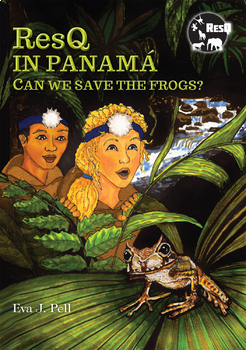Endangered Animals: Reading, Writing and Projects related to a story about frogs
- PDF
Description
This program is intended for use with the ResQ series of middle grade novels about rescuing endangered species. While the books are fictional adventures, they are heavily grounded in factual background. The books are well suited to classroom use, particularly for teachers who want to take an integrated approach to science, social studies and language arts.
The protagonists are young people with special skills in natural and physical sciences. They use these skills to devise tools for solving the problems they face in their rescues. One of the protagonists is home schooled and is required by her mother to write logs describing her adventures. These logs are the place where the factual underpinnings for the book are provided. The protagonists always partner up with adolescents in the home countries where they travel; these characters have insight into the terrain, communities etc. and provide imperative know-how for success.
This program is based on the third book in the series of free standing books. What follows is a summary of the story:
ResQ in Panamá: Can We Save the Frogs? Wheaton and Stowe join two Colombian college students on a journey to the Darién Gap in southern Panamá where they will survey frogs for a chytrid fungus which is causing global amphibian extinctions. Living in an indigenous village the team encounter more than just frogs, as floods, illegal refugees, and some dangerous species cross their paths. The reader will learn about the fungal disease, how it is monitored, and what scientists are doing to prevent extinctions of critical amphibian species. Children will be introduced to the rich biodiversity of this part of the world, how indigenous communities are participating in monitoring impact of climate change, and the culture and complexities of these people living in one of the most undeveloped parts of the world. Wheaton does not disappoint, as he comes up with yet more futuristic inventions to help save the day.
The study guide offered here was created to be used in the middle grade —3-5— classroom with sections that focus on scientific elements of the story —biological and physical; geographic and cultural information, a few math problems, reading comprehension and vocabulary. There are writing assignments, group projects, art activities and games.
· No prep is needed; this guide is perfect for independent study and/or group work
· Perfect for in-class, distance learning or homeschooling.
· Self explanatory — straight forward for teachers, parents, and students to follow!
If you are interested in using the book in your classroom Tumblehome Inc. will provide you with a significant discount. If you choose to use the study guide feel free to contact me at pell.author@gmail.com and I will provide you with a free teacher key to go with the guide
The ResQ in Panamá: Can We Save the Frogs? Novel Study is broken down into four sections:
Before You Read p 1 provides An introduction to the Red List of Threatened Species and some warm-up exercises
Reading Log p 3-4
Chapters 1-6 & Logs
Spanish word lookout p. 5
Character analysis p. 5
Geography and culture questions p. 6
Biodiverstiy questions p. 7
Vocabulary p. 8
Fun Facts from the logs —Geography and biodiversity questions - p. 9
Bonus question – Geography question p. 10
Chapter 7-12 & Logs
Spanish word lookout p. 11
Character analysis p 11-12
Geography and culture p.
Biodiversity questions p. 12
Vocabulary p. 13
Fun Facts from the logs —Biodiversity questions p. 14
Bonus Question – Spanish-related p. 14
Chapters 13-19A
Spanish word lookout p.15
Character analysis p. 15-16
Geography and culture p. 16-17
Technology p. 17
Fun Facts from the logs – Biodiverstiy and geography p. 18
Vocabulary p. 19
Chapters 20-glossary
Spanish word lookout p. 20
Technology – questions and art project p. 20-21
Character analysis p. 22
Biodiversity p. 23
Fun Facts from the logs —Biodiversity p. 24
Bonus question – Biodiversity question and art project p. 25-26
Vocabulary p. 27
Word Scramble p. 28
Final question – letter writing assignment p. 29


